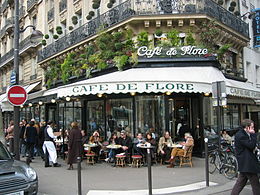
A coffeehouse, coffee shop, or café (French: [kafe]), is an establishment that serves various types of coffee, espresso, latte, americano and cappuccino. Some coffeehouses may serve cold beverages, such as iced coffee and iced tea, as well as other non-caffeinated beverages. A coffeehouse may also serve food, such as light snacks, sandwiches, muffins, cakes, breads, donuts or pastries. In continental Europe, some cafés also serve alcoholic beverages. Coffeehouses range from owner-operated small businesses to large multinational corporations. Some coffeehouse chains operate on a franchise business model, with numerous branches across various countries around the world.
While café may refer to a coffeehouse, the term "café" can also refer to a diner, British café (also colloquially called a "caff"), "greasy spoon" (a small and inexpensive restaurant), transport café, teahouse or tea room, or other casual eating and drinking place.[1][2][3][4][5] A coffeehouse may share some of the same characteristics of a bar or restaurant, but it is different from a cafeteria. Many coffeehouses in West Asia offer shisha (actually called nargile in Levantine Arabic, Greek, and Turkish), flavored tobacco smoked through a hookah. An espresso bar is a type of coffeehouse that specializes in serving espresso and espresso-based drinks.
From a cultural standpoint coffeehouses largely serve as centers of social interaction: a coffeehouse provides patrons with a place to congregate, talk, read, write, entertain one another, or pass the time, whether individually or in small groups. A coffeehouse can serve as an informal social club for its regular members.[6] As early as the 1950s Beatnik era and the 1960s folk music scene, coffeehouses have hosted singer-songwriter performances, typically in the evening.[7] The digital age saw the rise of the Internet café along similar principles.
- ^ Haine, W. Scott (1998-09-11). The World of the Paris Café. JHU Press. pp. 1–5. ISBN 0801860709.
- ^ Haine, W. Scott (2006-06-12). Alcohol: A Social and Cultural History. Berg. p. 121. ISBN 9781845201654. Archived from the original on 2017-03-29. Retrieved 2019-09-20.
- ^ The Rough Guide to France. Rough Guides. 2003. p. 49. ISBN 9781843530381. Retrieved 2019-09-20.
- ^ "Classic Cafes: London's vintage Formica caffs!". classiccafes.co.uk. Archived from the original on 2013-08-20. Retrieved 2013-09-28.
- ^ Davies, Russell (2005). Egg, Bacon, Chips and Beans: 50 Great Cafes and the Stuff That Makes Them Great. HarperCollins Entertainment. ISBN 9780007213788. Archived from the original on 2016-06-10. Retrieved 2013-09-28.
- ^ "Coffeehouse". MerriamWebster. Archived from the original on 2011-11-04. Retrieved 2012-04-07.
- ^ Rubin, Joan Shelley; Boyer, Paul S.; Casper, Professor Scott E. (2013). "Bob Dylan". The Oxford Encyclopedia of American Cultural and Intellectual History. USA: Oxford University Press. p. 317.